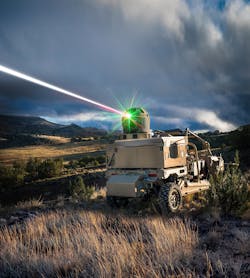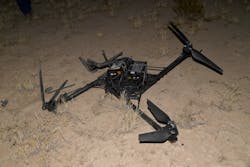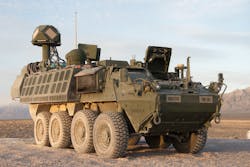High-energy laser weaponry delivers speed-of-light ‘hard kills’ to drones
Aerial drones are essentially the new improvised explosive devices (IEDs)—they’re relatively cheap and easily weaponized. Weaponized swarms of drones working together on a mission are an asymmetric threat that can quickly turn into an ugly situation. In the future, drones are expected to become faster, more autonomous, more difficult to detect or jam, and deadlier, with more sophisticated swarm attacks.
An arms race of sorts is quietly underway to be able to counter any countermeasures against drones. So the U.S. military is adopting a multilayered counter-drone approach to deal primarily with small drones (classified as Groups 1 and 2)—including commercial ones you can easily buy online and ones with fixed wings that look like tiny airplanes. Pinpoint accuracy at the speed of light makes high-energy lasers, a form of directed energy, one of the most promising options.
Drones can pose a threat within any environment because they’re difficult to spot and shoot down. That’s why, in 2018, Raytheon Intelligence and Space began working on a high-energy laser weapon system to help the U.S. military and its allies defend against them.
“Our defensive laser weapons use automated target cueing and a full spectrum of electro-optical/infrared sensors to track, identify, and quickly take down drones at tactically relevant distances,” says Justin Martin, chief engineer for high-energy lasers at Raytheon Intelligence & Space.Building a high-energy laser weapon system
In 2019, the U.S. Air Force deployed Raytheon Intelligence & Space’s first high-energy laser weapon system (HELWS) overseas (see Fig. 1). It’s certified for combat use and multiple systems are already in theater.
HELWS is a 15-kW-class laser weapon system that fires a silent near-infrared beam of light to shoot down a drone or deliver what’s known as a “hard kill” within the defense realm (see Fig. 2). It’s capable of taking out at least 40 drones coming at it, and has a fairly long (yet undisclosed) range.“Our high-energy lasers work on land, in the air, and at sea—providing 360-degree coverage to protect bases, airports, stadiums, and other high-value military or civilian assets,” says Martin. “These ruggedized systems are designed with an open architecture and scalable power to easily adapt to the demands of the mission.”
HELWS can be used as a standalone system or be installed on a variety of platforms. “It’s based on a combination of combat-ready Raytheon technologies, including a high-energy laser module and a beam control system,” he says.
The high-energy laser module design leverages a combination of commercial hardware, including commercial off-the-shelf fiber laser amplifiers, lithium-ion batteries, and state-of-the-art thermal management systems. “We scale our existing spectral beam combiner designs, and our architecture is aligned to reduce size and weight while improving efficiency,” says Martin.
HELWS’ beam-control system is based on an electro-optical/infrared sensor called a multispectral targeting system (MTS), which has 360-degree azimuth rotations with full hemispherical field of regard. A large aperture maximizes the optical detection range and day/night performance capability for 24/7 operations.
“By using a common aperture for the track sensor and high-energy laser, we eliminate any parallax between camera aperture and HEL or boresight errors,” Martin says. “Our beam director can identify highly maneuverable threats and passively track them, and it can also fire the laser beam at the exact spot on a threat that you want to target—such as a payload, detonator, or wing.”
Fiber laser technology used by the Raytheon Intelligence & Space team is evolving quickly, thanks to the ability to leverage investments and economies of scale from the commercial laser cutting and welding industry.
Why high-energy lasers?
High-energy lasers offer a nearly infinite number of shots, minimal logistics, and precision accuracy with very low collateral damage—all of which makes it an affordable alternative to traditional munitions. There are no munitions to be resupplied, inventoried, or stored, and training is fast and simple. Once you have HELWS, the cost per shot is basically the cost of the electricity to power it.
Their directed-energy cousins, high-powered microwaves, are also part of the U.S. Department of Defense’s multilayered approach. It uses essentially the same technology as household microwaves, but is millions of times more powerful, to disable all swarming drones within the swath of its electromagnetic pulse.
Deploying directed-energy technology offers significant advantages over conventional effectors, such as missiles or cannons (guns and howitzers), as well as nonkinetic effectors like electronic jamming and net deploying systems. “Conventional missile and cannon effectors deliver a hard kill, but with substantial disruption and expense,” says Martin.
Engagements with swarming drones are most likely to occur near roadways, commercial or industrial buildings, or within populated areas. “The collateral damage created by missiles or cannons poses a significant risk within these environments,” he points out. “Warfighters’ adversaries understand the cost of these missiles and use of it as a key tactic to purposefully deploy significant quantities of low-cost drones to create cost-prohibitive engagements for U.S. forces.”
Another important feature of high-energy lasers is their ability to plug into existing air defense systems—such as the National Advanced Surface-to-Air Missile System—to quickly find and drop drones. “HELWS enhances the capabilities of existing traditional air defense tactical equipment with focused laser-directed energy systems,” says Martin. “It rapidly detects, identifies, and defeats asymmetric threats by applying focused laser-directed energy on a precise point on a target to provide a hard kill with minimal to no collateral damage.”
Although nonkinetic effectors are less expensive solutions and deliver less collateral damage than missiles or cannons, they simply don’t provide an effective defense against these threats. “WiFi and GPS jamming techniques are commonly understood by adversaries and, with simple adjustments, drone threats are resistant to these techniques,” says Martin. “Due to the unique maneuverability and ever-changing flight patterns of small drone threats, other solutions such as net-deploying systems have proven to be easily avoidable.”
Raytheon Intelligence & Space has already completed full high-energy laser installation and testing on a range of tactical ground vehicles, commercial vehicles, as well as an Apache attack helicopter.
Scaling up
A more powerful laser weapon equates to greater functionalities, such as a longer range and faster defeat capabilities. “A 50-kW-class laser, for instance, can burn a hole through a small consumer drone in a flash, while detonating or deflecting a mortar within seconds,” Martin explains. “In many cases more power isn’t needed, and the 15-kW-class laser is the right-sized solution.”
When the Raytheon Intelligence & Space team needed more power while managing thermal issues and maintaining beam quality, they wanted to scale up to a 50-kW-class laser quickly. Instead of using four to six fiber laser amplifier modules like they do for their 15-kW-class laser, they bumped it up to 20 to 25 modules to create a 50-kW-class version.
“Fiber laser amplifier modules are robust building blocks that we can stack up to get the power and fiber required for the mission,” explains Martin. “But the real trick is aligning all of these separate beams of light into a single beam of light with the right characteristics for a laser weapon.”
The plan is to continue reducing size, weight, and power demands—which are critical for military applications—while increasing laser power to support high-energy laser usage on as many missions and platforms as possible.
“We’ll also continue automating the kill chain, with enhancements from artificial intelligence (AI) and machine learning to tackle the largest number of threats within the shortest possible timeframes,” he says. “Another significant challenge is building a laser weapon that can handle the rigors of the battlefield and making it possible to produce them efficiently within a factory setting.”
HELWS also has software capabilities to provide some automation to aid soldiers during engagements. But a human is still in the loop for positive visual identification of targets, and to make the decision to engage and fire the laser. “AI/machine learning is playing a role in continuing to advance system automation and engagement for scaling effectiveness, as more systems get deployed addressing an ever-increasing set of threats and threat scenarios,” Martin says.
Fielding HELWS systems in 2022
The next step for Raytheon Intelligence & Space’s high-energy lasers is to field the Directed Energy Maneuver Short-Range Air Defense (DE M-SHORAD) 50-kW system with the U.S. Army and teach soldiers how to operate it.
Soldiers trained in DE M-SHORAD simulators do virtual walkthroughs of the entire vehicle and laser system. During training, soldiers learn about the basics of lasers, laser safety, and how to operate the new weapon system. Then, they spend a week in a virtual environment before participating in live-fire drills.
The system features a large-aperture camera, so laser weapon gunners can zero in on a target, monitor and positively identify it, then press the button to fire at it.
DE M-SHORAD crews were thrilled to test a brand-new weapon, and “you could see it on their faces after they defeated a drone with the tap of a finger,” Martin says. “They were bought-in and ready to push forward with more involved and difficult engagements. The laser weapon gunners in the seat—taking down drone after drone—were believers after that.”
During live-fire exercises in 2021 at Fort Sill, OK, soldiers operated the system and effectively tracked, identified, and engaged a variety of targets. “Within a few days, Stryker crews with three soldiers each—a driver, crew commander, and laser gunner—went from training to operating the system and engaging targets,” Martin says.And more recently, in 2022, during four weeks of continuous live-fire exercises, a team led by Raytheon Intelligence & Space defeated multiple 60 mm mortar rounds with a 50-kW-class high-energy laser integrated on a Stryker combat vehicle (see Fig. 3). They also defeated small, medium, and large drones.
The first operational prototype is being used for system characterization, and lessons learned are being rolled into that system and into the remaining three operational prototypes being built. Final prototypes will be delivered as a platoon in 2022.
About the Author
Sally Cole Johnson
Editor in Chief
Sally Cole Johnson, Laser Focus World’s editor in chief, is a science and technology journalist who specializes in physics and semiconductors.




